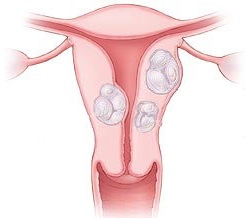Endometrial hyperplastic processes are possible at any age, but the maximum frequency of diseases is observed in the period of perimenopause. In the development of the disease, an important role is played by an unfavorable environmental situation, an increase in the number of chronic somatic diseases, hormonal disorders and a decrease in immunity.
Content
Endometrial hyperplastic processes are possible at any age, but their frequency increases significantly by the period of the perimenopause. The increase in the incidence of hyperplastic processes of endometrials is associated both with an increase in life expectancy and with unfavorable environmental conditions, an increase in the number of chronic somatic diseases and a decrease in immunity in women.
Mechanism for the occurrence of the disease
 Endometrium is the target organ for sex hormones due to the presence of specific receptors in it. Balanced hormonal impact through cytoplasmic and nuclear receptors provide physiological cyclic transformations of the uterine mucous membrane. Violation of hormonal status can lead to a change in the growth and differentiation of endometrial cell elements and entail the development of hyperplastic processes.
Endometrium is the target organ for sex hormones due to the presence of specific receptors in it. Balanced hormonal impact through cytoplasmic and nuclear receptors provide physiological cyclic transformations of the uterine mucous membrane. Violation of hormonal status can lead to a change in the growth and differentiation of endometrial cell elements and entail the development of hyperplastic processes.
The leading place in the pathogenesis of the endometrium hyperplastic processes is given to a relative or absolute increase in estrogen level, absence or insufficient anti-estrogenic influence of progesterone. Causes of hyperstream:
- Anovulation due to persistence or atresia follicles
- Hyperplastic processes in ovaries or hurry-non-ovarian tumors (stromal hyperplasia, cottage, granules, tumor, cell tumors, and t.D.)
- Violation of the gonadotropic function of the pituitary
- Hyperplasia of the adrenal cortex
- Improper use of hormonal drugs (estrogens, anti-estrogens)
However, the endometrium hyperplastic processes can develop and with undisturbed hormonal ratios. In the development of such pathological processes, the leading role is given to disorders of the tissue reception. Infectious inflammatory changes in endometrials can lead to the development of endometrial hyperplastic processes in 30% of patients.
In the pathogenesis of endometrial hyperplastic processes, the exchange and endocrine disorders also occupy:
- Changes in fat exchange
- Violations of metabolism of sex hormones in the pathology of the hepatobiliary system and the gastrointestinal tract
- Reducing immunity
- Thyroid disorders
Endometrial hyperplasia development options
I.IN. Bokman put forward the concept of two pathogenetic embodiments of endometrial hyperplastic processes. The first option is characterized by a variety and depth of hyperastrosis in combination with disorders of fat and carbohydrate metabolism and manifests itself in annevutaneous uterine bleeding, infertility, late occurrence of menopause, ovarian hyperplasia, in combination with fminizing ovarian tumors and polycystic ovarian syndrome. Often there are momas and diffuse endometrial hyperplasia, against the background of which polyps occur, the foci of atypical hyperplasia of endometrial and cancer. Exchange disorders lead to obesity, hyperlipidemia and diabetes.
With a second pathogenetic version, these endocrine-exchange disorders are expressed in fuzzy or generally absent; Fibrosis stroma ovarian combines with a normal structure or endometrial atrophy, with the advent of polyps, focal hyperplasia (including atypical) and endometrial cancer.
In recent years, a complex system of factors involved in cellular regulation has been revealed and the ideas about intercellular interaction and intracellular processes in hormone-dependent tissues have been expanded. So, it was established that in the regulation of the proliferative activity of endometrial cells, along with estrogen, a number of biologically active compounds are involved (polypeptide growth factors, cytokines, arachidonic acid metabolites), as well as the immunity system. In the regulation of the processes of tissue homeostasis and the pathogenesis of proliferative diseases, an important role belongs not only to the increase in cell proliferation, but also a violation of the regulation of cell death (apoptosis). The resistance of endometrial cells to the programmed cell death (apoptosis) leads to the accumulation of modified and excessive proliferating cells, which is characterized by neoplastic changes in endometrial. Hyperplastic changes are usually exposed to the functional layer of endometrial, much less often - basal.
Thus, the pathological transformation of the endometrium is a complex biological process, affecting all the links of the neurohumoral regulation of the body of a woman.









